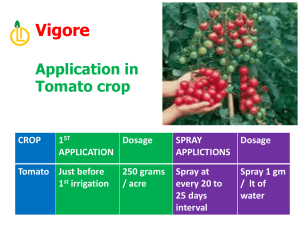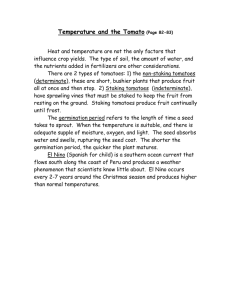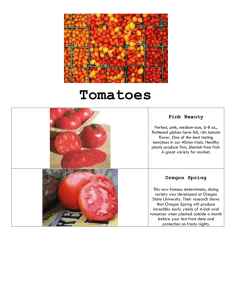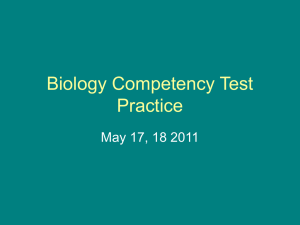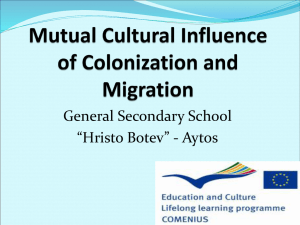Production guidelines: Tomato
advertisement
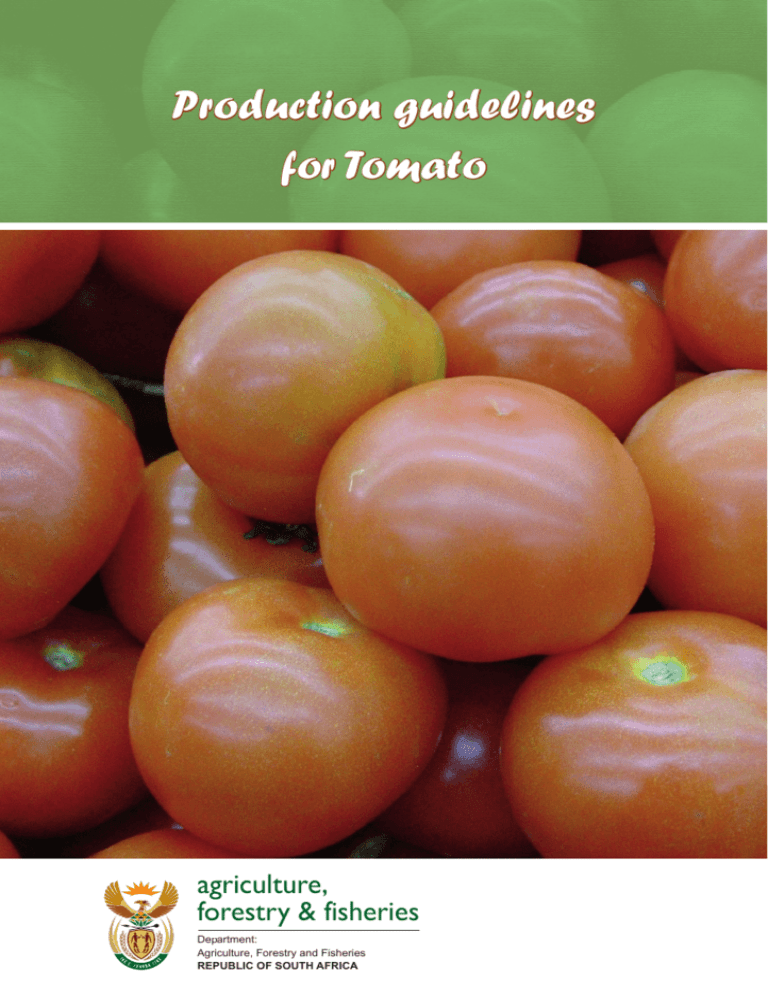
Production guidelines for Tomato agriculture, forestry & fisheries Department: Agriculture, Forestry and Fisheries REPUBLIC OF SOUTH AFRICA Production guidelines for Tomato DEPARTMENT OF AGRICULTURE FORESTRY AND FISHERIES Directorate Plant Production Obtainable from Resource Centre Directorate Agricultural Information Services Private Bag X144, Pretoria, 0001 South Africa The web: www.daff.gov.za/publications Published by Directorate Agricultural Information Services Department of Agriculture, Forestry and Fisheries Private Bag X144, Pretoria, 0001 South Africa For further information please contacts Directorate Plant Production, Division Vegetable Crops Tel: 012 319 6072 Fax: 012 319 6372 E-mail: DPP@daff.gov.za Disclaimer This document has been compiled by the Department of Agriculture, Forestry and Fisheries and every effort has been made to ensure accuracy and thoroughness of the information contained herein and all liability for any errors, omissions or inaccuracies in such information and data, whether attributable to inadvertence or otherwise. The Department of Agriculture, Forestry and Fisheries therefore accepts no liability that can be incurred resulting from the use of this information. CONTENTS PART I: 1. 2. 3. 4. 5. 6. 7. 8. General aspects Classification ........................................................................ 1 Origin and distribution .......................................................... 1 Production levels and areas in South Africa ............................ 1 Major production areas in South Africa ................................ 1 Cultivars ................................................................................. 1 Description of plant ............................................................... 2 Climatic requirement ............................................................. 2 Soil requirement ................................................................... 3 Part ii: 1. 2. 3. 4. 5. 6. 7. 8. 9. 10. Cultivation practices Propagation .......................................................................... Soil preparation .................................................................... Planting ................................................................................. Fertilisation ........................................................................... Irrigation ................................................................................ Weed control ........................................................................ Pest control ........................................................................... Disease control ..................................................................... Other cultivation practices .................................................... Harvesting methods ............................................................. 3 3 3 3 4 4 5 6 8 9 Part iii: 1. 2. 3. 4. 5. 6. Post-harvest handling Post-harvest handling............................................................ Grading ................................................................................ Packing ................................................................................. Storage ................................................................................. Transport ............................................................................. Marketing ............................................................................. 10 10 10 10 11 11 Part iv: Production schedules ........................................................... Part v: Utilisation .............................................................................. 13 References ........................................................................................... 13 Part 1: General aspects 1. Classification Scientific name: Lycopersicon esculentum Mill. Common names: Tomato, Tamati, Tamatiso, uTamatisi Family: Solanaceae 2. Origin and distribution Tomato is indigenous to the Peru and Equador region in South America and it probably evolved from Lycopersicon esculentum var. cerasiforme, the cherry form. However, it was domesticated and first cultivated in Central America by early Indian civilisations of Mexico. The Spanish explorers introduced tomato into Spain and it was later taken to Morocco, Turkey and Italy. In Italy and France, it was termed “love apple”. It was widely believed that the tomato was poisonous and its use as a food crop was only accepted in the 18th century. Tomato is now one of the most popular and widely grown vegetables around the world. 3. Production levels and areas 3.1 South Africa Tomatoes are the second most important vegetable commodity after potatoes, planted to about 6 000 hectares. Tomatoes contribute about 24 % of the total vegetable production in South Africa. 4. Major production areas in South Africa Tomatoes are grown all over the country in summer and in winter in frost-free areas, and their production is concentrated in Limpopo, the Mpumalanga Lowveld and Middleveld, the Pongola area of Kwazulu-Natal, the southern parts of the Eastern Cape, and the Western Cape. Growing of tomatoes in tunnels is becoming a popular and important crop production method in South Africa. 1 5. Cultivars The choice of cultivars is based on fruit quality quality, adaptability and reliability reliability, susceptibility to diseases and pests, plant growth habit, the specific market and the planting time. The fresh market cultivars include Florodade, Heinz 1370, Karino, Rodade, Fortress, Hytec, Star 9001, Star 9003, Sundance and Zeal. Baldo, Blockbuster, Disco, P 747 and Shirley are also fresh market cultivars that have a long shelf life. Tomato cultivars suitable for jam or preserving include HTX 14, Legato, Roma VF, Rossol, Star 9056F, Sun 6216 and UC 82B. Cherry tomato cultivars are Bamby and Josephine while those suitable for planting in tunnels are Atletico, Daniella and Gabriella. The Roma VF cultivar can be sown from spring to summer, but planning to sow in September is advisable. It takes between 120 to 150 days to mature. 6. Description 6.1 Mature plant The tomato is a perennial but is grown as an annual plant. It is a branching, herbaceous plant with hairy, weak, trailing stems. The leaves are hairy and vary in size. It bears yellow flowers in clusters. The fruits are round to lobed and they vary in size and colour ranging from red, pink or yellow when ripe. Flat, slightly curved, hairy, light brown seeds are produced. 6.2 Essential parts The tomato is grown for its fruits. Botanically, the fruit is a berry and it has two or more cavities containing seeds that are embedded in a gelatinous matrix that softens as the fruit matures and seeds are fully developed. 7. Climatic requirements 7.1 Temperature Tomato is a warm-season crop that is sensitive to frost. An average daily mean of 20 ° to 24 °C is optimum for growth, yield and fruit quality. Fruit set and quality are poor at temperatures below 12 °C and 35 °C. Hot, dry winds cause excessive flower drop while continuous moist, rainy weather conditions 2 result in the occurrence and spread of foliar diseases. It is therefore recommended that tomatoes be grown in dry areas under irrigation. 8. Soil requirements Tomato has given good results when grown in well-managed sandy loams and heavy clay loams free of hardpan but best results are obtained in deep, well-drained loams. The soil should be rich in organic matter and plant nutrients, with a pH value of 6 to 7. Part ii: Cultivation practices 1. Propagation Tomato is propagated from seed. 2. Soil preparation The soil should be well-prepared, loose and in good tilth. 3. Planting Seedlings are raised in seedbeds and transplanted to the field. Transplanting is preferable if hybrid seed is used, for early plantings and when producing for the fresh market. Direct seeding is usually done if the crop is going to be mechanically harvested or processed. The seed are broadcasted on the beds lightly covered with soil. Seedlings are usually ready for transplanting three to four weeks after sowing and they should be transplanted on moist soil. The seedbeds should be irrigated after sowing and it should be done regularly until the seedlings reach a height of 5 to 7 cm 4. Fertilisation Tomato is a heavy feeder of plant nutrients including nitrogen, phosphorus and potassium and it responds well to organic fertilisers. The amount of fertiliser applied is influenced by fertility status of the soil, season and the cultivar. The plants have a moderately high requirement of nitrogen. Nitrogen promotes better growth and better flower and fruit set. A minimum of 250 kg per hectare of nitrogen is recommended in high rainfall areas or for high production. Approximately a quarter of nitrogen is applied at planting while the re- 3 mainder is applied in the first six to eight weeks of growth at two to three week intervals. Further light dressings are applied over the next six or more weeks. Tomato also requires high levels of potassium. Adequate levels of potassium result in improved colour, taste, firmness, sugars, acids and solids of the fruit. Plant cells are also strengthened. A minimum of 100 kg of potassium should be applied per hectare. Phosphorus promotes root development, early flowering and fruit set and ensures more vigorous growth. A total of 40 to 60 kg of phosphorus per hectare is suggested in soils with a built-up of the nutrient. It is recommended that phosphorus be banded in acid soils. Tomatoes also require micronutrients for growth and development. Deficiencies of magnesium, calcium, and molybdenum are common in acid soils while boron and copper deficiencies are not often found in tomatoes. However, boron deficiency, if it occurs, results in fruit cracking, pitted and corky areas, deformed shape, malformation and uneven fruit ripening. Iron has been found to be deficient on calcareous, alkaline soils or after heavy applications of lime. Manganese deficiencies are mainly found in calcareous soils. 5. Irrigation Irrigation is critical in tomato production. It is important to supply sufficient water at critical times, such as immediately after sowing or transplanting. Excess irrigation after a long dry spell without prior light irrigation results in fruit cracking. During the first four weeks apply 21 mm of water per week, for during the following eight weeks (with 38 mm per week) Plants that are irrigated late in the season produce watery fruits of poor quality. Sometimes it is best not to use an overhead sprinkler irrigation system because wet leaves encourage early and late blight. 6. Weed control Weeds can be controlled chemically or mechanically. Chemical weed control can be used by applying registered chemicals. Mechanical cultivation should be shallow and not too close to the plant; this will prevent damage to the plants. Hand-hoeing is also practised, especially with tomato production under protection. 4 7. Pest control Nematodes Tomato is attacked by various nematodes although the root-knot nematode is the most prevalent. Attack by nematodes is more likely in sandy soils and during warm conditions. They attack roots causing galls to develop and reduce the size and efficiency of the root system. Stunting of plants, reduced fruit set and yield and quality result from infestation. Plants also show drought symptoms and may sometimes wilt and die even when moisture is adequate. CONTROL • Practise crop rotation • Proper sanitation is important (keep cultivated fields clean from weeds and other foreign material that can serve as host for the killer pest). • Always destroy infected plants and away from the field. Rust mite (Aculops lycopersici) Initially, the lowest leaves curl and show a silvery gloss on their lower surfaces. The leaves later turn bronze, wither and die. Stems become purplish brown in colour while the fruits become rusty brown and coarse, with cracks on the surface. CONTROL • Destroy affected plants and practise crop rotation Red spider mite (Tetranychus spp.) The red spider mite is more common and serious in hot, dry weather but their numbers are reduced after rain. They feed on the lower sides of the leaves and spread over the whole plant when populations increase. Initial symptoms are chlorotic stipples on the upper side of leaves. Leaves may later turn yellow, become bronze and dry out. Severe infestation is characterised by fine webbing. CONTROL • Practise crop rotation 5 • Proper sanitation is also important (keep cultivated fields clean from weeds and other foreign material that can serve as host of the killer pest). • Always destroy infected plants and away from the field Plusia looper (Chrysodeixis acuta) Young larvae feed on the undersides of leaves and skeletonise them. Older ones attack the fruit, eating shallow and often causing extensive cavities in the fruit. CONTROL • Practise crop rotation • Proper sanitation is important (keep cultivated fields clean from weeds and other foreign material that can serve as host for the killer pest). • Always destroy infected plants away from the field. Cutworm (Agrotis spp.) The stems of young plants are cut off at or near ground level. CONTROL • Practise crop rotation • Proper sanitation is important (keep cultivated fields clean from weeds and other foreign material that can serve as host for the killer pest) • Always destroy infected plantsand throw them away from the field Aphids Although tomato is attacked by several kinds of aphids, the green peach aphid (Myzus persicae) is the most prevalent. Severe infestations under dry conditions may result in premature die-back of plants. CONTROL • Crop rotation is essential. • Proper sanitation is important (keep cultivated fields clean from weeds and other foreign material that can serve as host for the killer pest) • Always destroy infected plantsand throw them away from the field 6 Thrips Several thrips also attack tomato but Thrips tabaci is the most important one one. Thrips chafe the surfaces and suck the sap from broken cells on flowers and young fruit. Additional damage includes blossom drop, scarring of fruit and malformation of the leaves. Thrips also act as vectors of kromnek (spotted wilt virus). CONTROL • Practise crop rotation • Proper sanitation is important (keep cultivated fields clean from weeds and other foreign material that can serve as host for the killer pest) • Always destroy infected plants and throw them away from the field Leafminer/potato tuber moth (Phthorimaea operculelle) The larvae make irregular channels within the leaves and leave brown spots. The stems are also mined in some instances. CONTROL • Practise crop rotatio • Proper sanitation is important (keep cultivated fields clean from weeds and other foreign material that can serve as host for the killer pest) • Always destroy infected plants and throw them away from the field Erinose mite (Eriophyses lycopersici) These mites are found in tropical and subtropical areas. The pest causes formation of dense patches of fine, white hairs on the younger leaves and stems CONTROL • Practise crop rotation. • Proper sanitation is important (keep cultivated fields clean from weeds and other foreign material that can serve as host for the killer pest). • Always destroy infected plants and throw them away from the field 7 8. Disease control Early blight The disease is caused by the fungus Alternaria solani. CONTROL • It is advisable to always to practise crop rotation. • Proper sanitation is also important (keep cultivated fields clean from weeds and other foreign material). • Use registered chemicals. Late blight This is caused by a fungus, Phytophthora infestans. CONTROL • It is advisable always practise crop rotation. • Proper sanitation is important (keep cultivated fields clean from weeds and other foreign material). Bacterial wilt This bacterial disease, caused by Pseudomonas solanacearum, is soil-borne and infects the roots and the stem. Infection causes sudden wilting with no yellowing or necrosis. The stem pith gradually decays and leaves a hollow stem. CONTROL • Practise crop rotation. • Control drainage. • Practice proper sanitation. • Use resistant cultivars. Fusarium wilt The fungus Fusarium oxysporum m causing the disease is soil-borne. It attacks the plant through the roots and causes plugs to form in the vascular tissue. 8 The plugs restrict the uptake of water and nutrients, resulting in wilting and yellowing. A discolouration is also observed on the vascular tissue. CONTROL • Plant resistant cultivars and practise crop rotation. Bacterial canker The disease is caused by Corynebacterium michiganense and is introduced by contaminated seed and transplants. Often only one side of the plant is often affected. Infected plants show wilting and necrosis on lower leaves with streaks extending to the stems and the underside of the petioles. The streaks eventually break to form cankers. The stem later becomes yellow on the inside and fruit may develop dark rough spots with a white halo. CONTROL • Use clean seed. • Practise crop rotation. Bacterial speck Bacterial speck is caused by Pseudomonas syringae and it is prevalent in cool, moist weather conditions. It causes lesions on fruit and stems. Sunken black spots surrounded by dark green halos are observed on infected green fruit. CONTROL • Plant resistant cultivars and practise crop rotation. • Use registered chemicals available at nurseries, cooperatives and retail stores Bacterial spot Xanthomonas vesicatoria causes bacterial spot and it affects all plant parts. Spots on the fruit are raised and scabby and those on the leaves and stems tend to aggregate. CONTROL • Seed treatment before sowing is essential. 9 • Also use resistant cultivars Septoria leafspot The disease is caused by Septoria lycopersici. Infected leaves develop dark spots with gray, sporulating centres. CONTROL • Seed treatment before sowing is essential. • Use registered chemicals. 9. Other cultivation practices 9.1 Training Training of plants has a number of benefits, including improved spraying to control foliar diseases and pests, less sunburn, better air circulation around the plant and less fruit rotting. Cultivars that have an indeterminate growth habit require training on trellises or suspended on twine from overhead wires. The crop grown for the fresh market should also always be trellised. 9.2 Pruning Pruning influences the flowering and fruiting of the tomato plant. Plants are pruned by pinching off lateral branches as they appear in the leaf axils. It has been reported that pruning reduces early and total yield, detrimentally affects quality and increases the incidence of viral diseases and other disorders. This practice is not recommended for tomatoes grown in the open field. 9.3 Crop rotation A three-to four year-rotation programme with non-related crops is recommended to reduce build-up of pests and diseases. 10.Harvesting 10.1 Harvest maturity The end-use of the produce and the distance to the market will determine when to start harvesting. Tomatoes for processing are harvested when they are fully mature. Fruit to be shipped long distance is harvested at a less mature stage, while the crop for local markets is picked at a more mature stage. 10 Harvesting is done at the following maturity stages 1. At the pale green stage • When the fruits have a pale green colour, particularly around the blossomend of the fruit • When the contents of the seed cavity are jelly-like and fill the entire seed cavity • When the hard dry appearance has disappeared 2. At the early light red stage • When fruits begin to show a red shade at the bottom end and occasionally on the sunny side of the fruit 3. At the light red stage • When the whole fruit has a rosy or light red colour. 4. At the red or ripe stage • When the greater part of the fruit has a full red colour • When the fruit is firm with no signs of softening 10.3 Harvesting methods Tomatoes for the fresh market are harvested by hand while those for processing purposes are harvested mechanically, especially in developed countries. It is recommended that picking be done early in the morning. Part iii: Post-harvest handling Tomatoes should be moved from the field to the packhouse as soon as possible and should not be left in a hot area for long periods. In the packhouse, tomatoes are cleaned, graded, waxed, wrapped and packaged. 1. Grading Tomatoes are graded according to size, colour and quality. Fruit of good quality must be sound, well-shaped, uniform in size and colour and be free from diseases, cracks, blemishes, foreign matter or spray residues. 11 2. Packing Higher grade fruit are packed in trays made of wooden boxes or cartons cartons. Fruits of lower grade are packed in jumble packs. 3. Storage The storage conditions are dictated by the stage of ripeness. Generally, tomatoes should be stored at 12 °C and 86% to 90 % relative humidity. 4. Marketing Fruit and Vegetable markets are among the potential markets for tomatoes in South Africa. Part iv: Production schedules Planting X X X X Fertilisation DECEMBER SEPTEMBER X NOVEMBER AUGUST X OCTOBER JULY Soil sampling Soil preparation JUNE MAY APRIL MARCH FEBRUARY JANUARY ACTIVITIES X X X Irrigation X X X X X Pest control X X X X X X X Disease control X X X X X X X Weed control X X X X Leaf sampling Harvesting X X Marketing X X X 12 Part v: Utilisation Tomatoes are used in a variety of ways. Ripe tomatoes are consumed fresh or processed into puree, paste, powder, ketchup (tomato sauce), sauce and soup or canned as whole fruits. The unripe ones are pickled or used for preserves. Medicinal uses of tomatoes have been documented. Tomato extract has been used to treat various diseases in traditional medicine in Japan, Greece, Peru and Guatemala. Hot water extract of dried fruit has been used to treat ulcers, wounds, hemorrhoids and burn while tomato poultice has been used to treat edema during pregnancy. Fresh fruit apparently aid in digestion and to treat kidney and liver problems. The fruit is also rich in lycopene and vitamin C. REFENCES KwaZulu-Natal Department of Agriculture and Environmental Affairs. 2001. Vegetable production guidelines for KwaZulu-Natal. Pietermaritzburg. Dr W. Nell and Prof. B. Wessels. Growing vegetables: A comprehensive guide on how to establish, maintain and manage a vegetable garden. University of the Free State. NUFARMER & AFRICAN ENTREPRENEUR, April 2006. Tigchelaar, E.C. 1986. Tomato Breeding. Tindall, H.D. 1968. Commercial Vegetable Growing. Oxford University Press. Oxford. Trench, T.N., Wilkinson, D.J. & Esterhuysen, S.P. 1992. South African Plant Disease Control Handbook. Farmer Support Group, University of Natal. Pietermaritzburg. 13 Notes ..................................................................................................................... ..................................................................................................................... ..................................................................................................................... ..................................................................................................................... ..................................................................................................................... ..................................................................................................................... ..................................................................................................................... ..................................................................................................................... ..................................................................................................................... ..................................................................................................................... ..................................................................................................................... ..................................................................................................................... ..................................................................................................................... ..................................................................................................................... ..................................................................................................................... ..................................................................................................................... ..................................................................................................................... ..................................................................................................................... ..................................................................................................................... ..................................................................................................................... ..................................................................................................................... .....................................................................................................................
